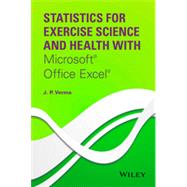This book introduces the use of statistics to solve a variety of problems in exercise science and health and provides readers with a solid foundation for future research and data analysis.
Statistics for Exercise Science and Health with Microsoft Office Excel:
- Aids readers in analyzing their own data using the presented statistical techniques combined with Excel
- Features comprehensive coverage of hypothesis testing and regression models to facilitate modeling in sports science
- Utilizes Excel to enhance reader competency in data analysis and experimental designs
- Includes coverage of both binomial and poison distributions with applications in exercise science and health
- Provides solved examples and plentiful practice exercises throughout in addition to case studies to illustrate the discussed analytical techniques
- Contains all needed definitions and formulas to aid readers in understanding different statistical concepts and developing the needed skills to solve research problems








